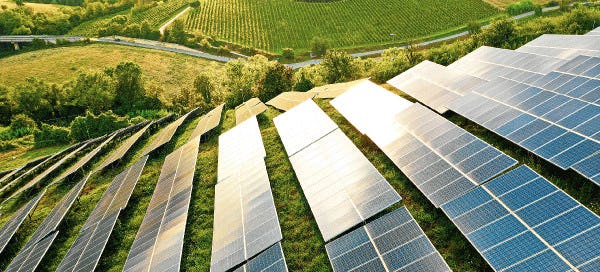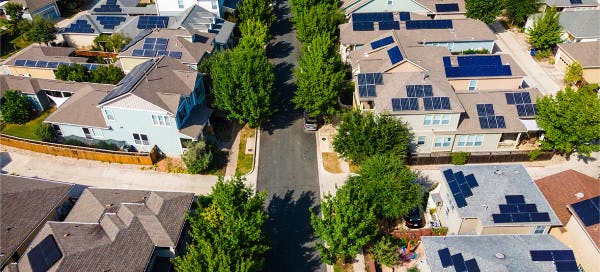Solar Incentives for Texas Residents: Benefits of Going Green
There are many benefits of solar energy, ranging from doing what’s better for the environment to helping save you money on your monthly electricity bills. Not only is solar a renewable energy source, derived naturally from the sun, but it also helps stabilize the grid and make our energy infrastructure less dependent on energy produced from fossil fuels, which have fluctuating prices. It even supports local jobs when the energy is generated right here in the Lone Star State.
To learn more about the benefits of solar energy, read our article What are the Advantages of Solar Energy. And keep reading to learn how you can tap into incentives to help solar power your home.
Cost of Solar Panels in Texas
According to Forbes magazine, the cost of solar panels in Texas is lower than the national average, and you’ll get more of a return on your investment here, since the Lone Star State gets more than 200 days of sun every year.
According to Energy Sage, as of June 2024, the average solar panel system (including installation) costs $2.36/W in Texas. For example, for a 5 kW installation, this comes out to an average of $11,816 before you receive any incentives. The federal tax credit alone can drop this price by 30%.
In addition to the federal credits that reduce the amount of tax you owe, other incentives can include rebates that give you money back after your solar installation, and performance-based incentives that provide ongoing payments from selling excess energy back to the grid.
One-Time Solar Incentives in Texas
Perhaps the most important solar incentive available is the federal solar tax credit program, which started in 2016. In 2024, it still brings tremendous value, because it can save you thousands of dollars in the form of a 30% tax credit – and there’s no limit to the amount you can claim.
The Lone Star State also offers a property tax exemption for the increase in property value that comes from installing solar panels on your home. A Texas solar installation can add an average of 4.25% to your home's value.
Depending on your exact location in Texas, solar incentives may be available from local governments or your utility company. See a list of Texas Solar Incentives here, or read our article What Are Solar Incentives to learn more.
Ongoing Solar Incentives in Texas
At Rhythm Energy, because of our commitment to renewable energy we even offer Texans a solar buyback plan. If your panels produce more power than you use, then you can sell the excess back to the grid. So once you’ve invested in installing solar panels, not only will you save money on electricity, you can even make money.

Dispelling Myths About Solar Energy in Texas
While installing solar panels might not be right for everyone, there are many myths about solar energy, and we’re here to set the record straight.
Myth 1: Solar Energy Is Too Expensive and Not Worth the Investment
The cost to install solar panels in Texas is lower than the national average. On top of this lower cost and applicable financial incentives, homeowners can make money by selling excess power to utility companies.
Not only are solar panels a green and eco-friendly source of electricity, but they can help you lower energy bills, up to $2,000 a year. They even help increase the value of your home, by an average of $15,000.
Myth 2: Solar Panels Are Not Efficient enough to Be Worthwhile
Solar panels are more efficient than ever, with further improvements coming as Texas-based companies conduct research and development. Plus, they are already improving the power grid as a whole. Given increasing power grid uncertainty, solar panels and batteries can allow Texans to be energy-independent during power outages and other energy crises.
Myth 3: Solar Energy Is Only for the Wealthy
Not true! Although it can take a fairly hefty investment up front to install solar panels on your home, federal and local incentives help offset these costs. Paying for solar panels out of pocket is the best way to make the most of your investment. But there are other options: you can take out a solar loan, which lets you make monthly payments on your panels (typically over the course of around 10 years) or you can sign a lease to rent panels from a solar company.
Myth 4: Solar Panels Can't Produce Enough Energy for my Home
How do you know for sure that solar can support your home? Begin by understanding your average monthly energy usage, which you can calculate by looking at old electricity bills. According to The U.S. Energy Information Administration, the average home in Texas uses 1,176 kWh a month or 14,112 kWh per year. Smaller homes can use significantly less energy: for example, a 1,000 square foot home can only require around 3,600 to 4,800 kWh per year.
For homes around 1,000 square feet, a 3 kWh solar panel system will generate around 3,600 to 4,800 kWh per year.
For homes around 2,000-2,500 square feet, a 5 kWh solar system will produce roughly 6,000 to 8,000 kWh per year.
For homes greater than 5,000 square feet, a 10 kWh solar panel system can generate between 12,000 to 16,000 kWh per year.
And remember: even if your total energy usage isn’t 100% provided by solar panels, you can still significantly reduce your electricity bill with a solar array.
Maximize Your Solar Investment and Sell to the Grid
Make the most of your investment in solar panels and get bill credits for the excess power being generated from them. With Rhythm Energy’s PowerShift Solar Buyback 12, Texas customers with residential solar arrays less than 20 kilowatts in capacity are eligible.
Our PowerShift Solar Buyback 12 gets you one of the best buyback rates in Texas.
Use power during off-peak hours and sell back during on-peak hours to save.
Unlimited credit rollover and no cap on bill credits.
Time-dependent import and export rates.
Curious If Solar Energy is Right for You?
We offer a FREE, independent solar concierge who can give you an unbiased, honest assessment as to whether your home is suited for solar and how much you could save on your electricity bills. Our friendly, unbiased experts will help you save by making sure you have the perfect solar system, installer, and quote.
FAQs
What solar incentives are available in Texas?
One-time incentives include a federal tax credit as well as potential property tax exemptions and local incentives. Ongoing incentives include the possibility of selling excess energy that you generate with your solar array, but don’t use to power your home, back to the grid.
How do I apply for solar tax credits?
Start at the Department of Energy website, or contact the knowledgeable experts at Rhythm Energy, who can help you determine if solar energy is right for your home for a free consultation.
What are the initial costs of installing solar panels?
The average cost of installing a 5 kilowatt solar panel system in 2024 is around $11,816. But this is before the federal tax credit, and other options are on the table, including renting your roof space to a solar panel partner.
How much can I save with solar energy?
Solar panels can help lower energy bills by up to $2,000 a year. They can also increase the value of your home, by an average of $15,000.
Can I sell excess solar energy back to the grid?
Through a process called “net metering”, Rhythm Energy will evaluate how much of the electricity that you buy from the grid was used in a month, then deduct the credit for the surplus generation. The export rate for solar buyback credits will be a different rate than your energy rate, and credits can be used toward your energy rate only. Our solar buyback program credits have no cash value, cannot be used toward non-commodity charges, and can only be redeemed for Rhythm Energy bill credits on the meter where they were generated, but they can be rolled over each month.
How long do solar panels last?
Solar panels are designed to last for decades, typically lasting 20–40 years. It’s important to note, however, that their efficiency and power production will decrease over time, so it’s a good idea to have regular maintenance from your solar contractor.




